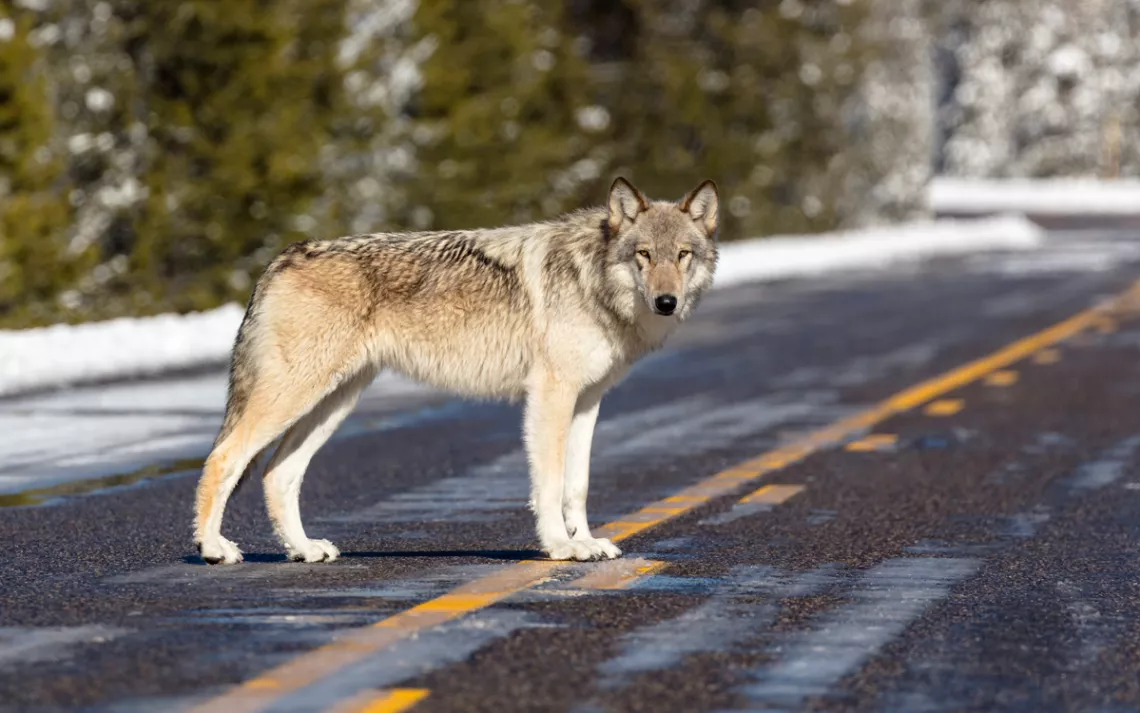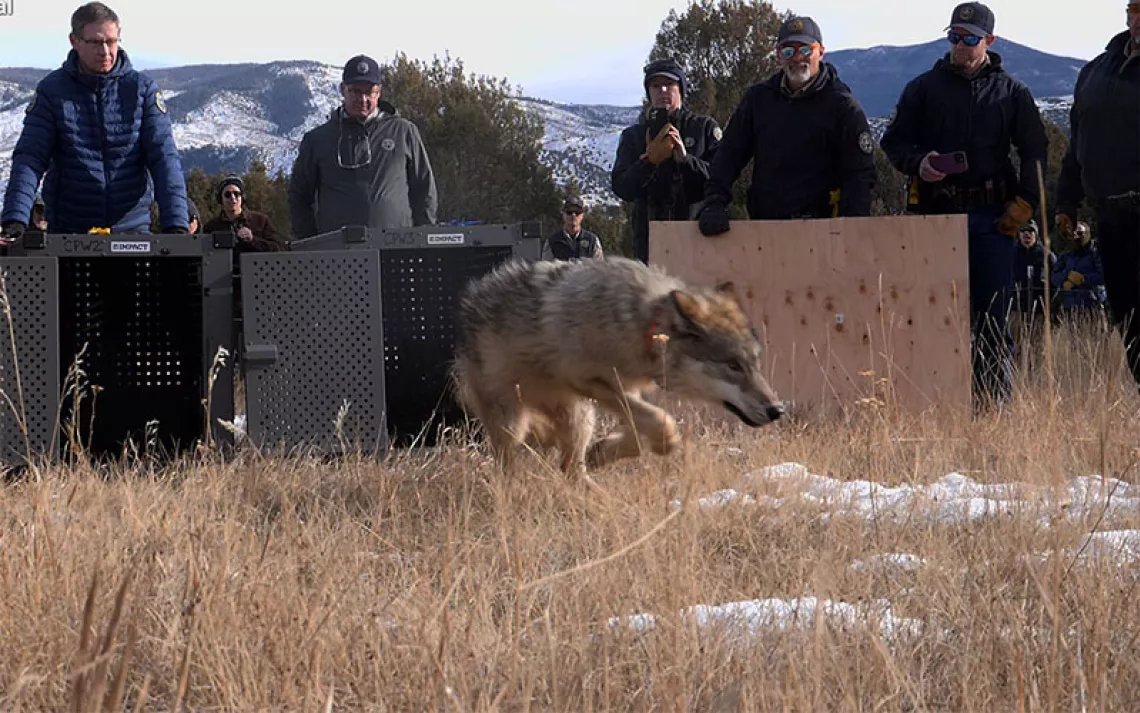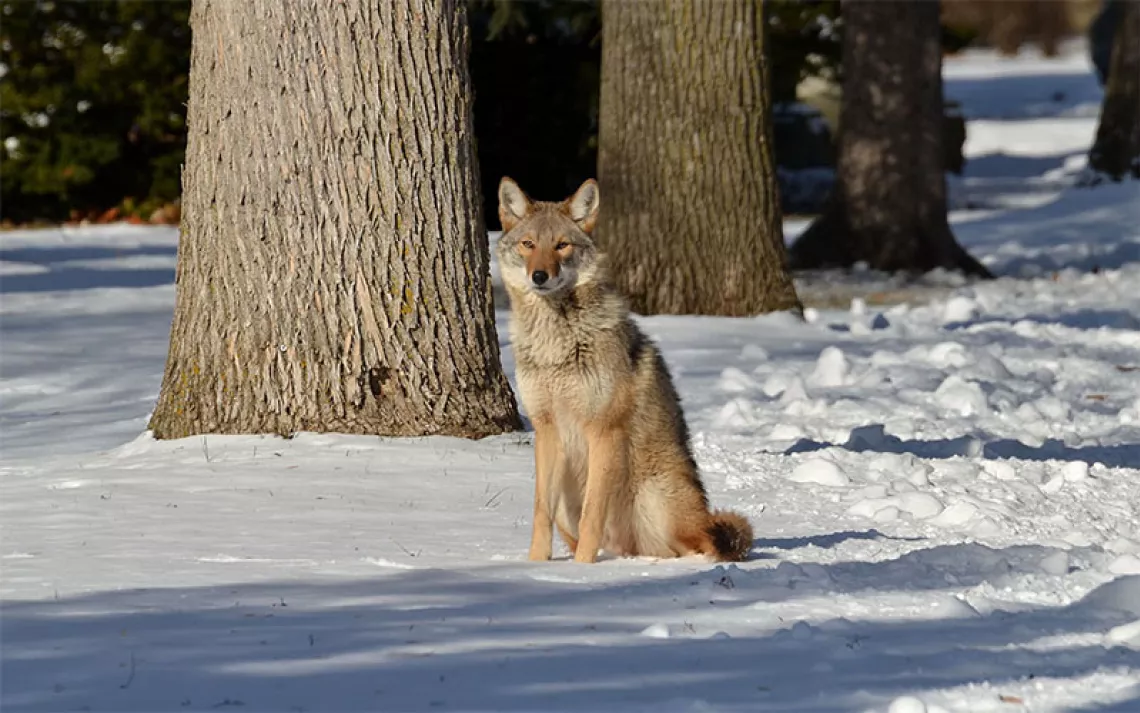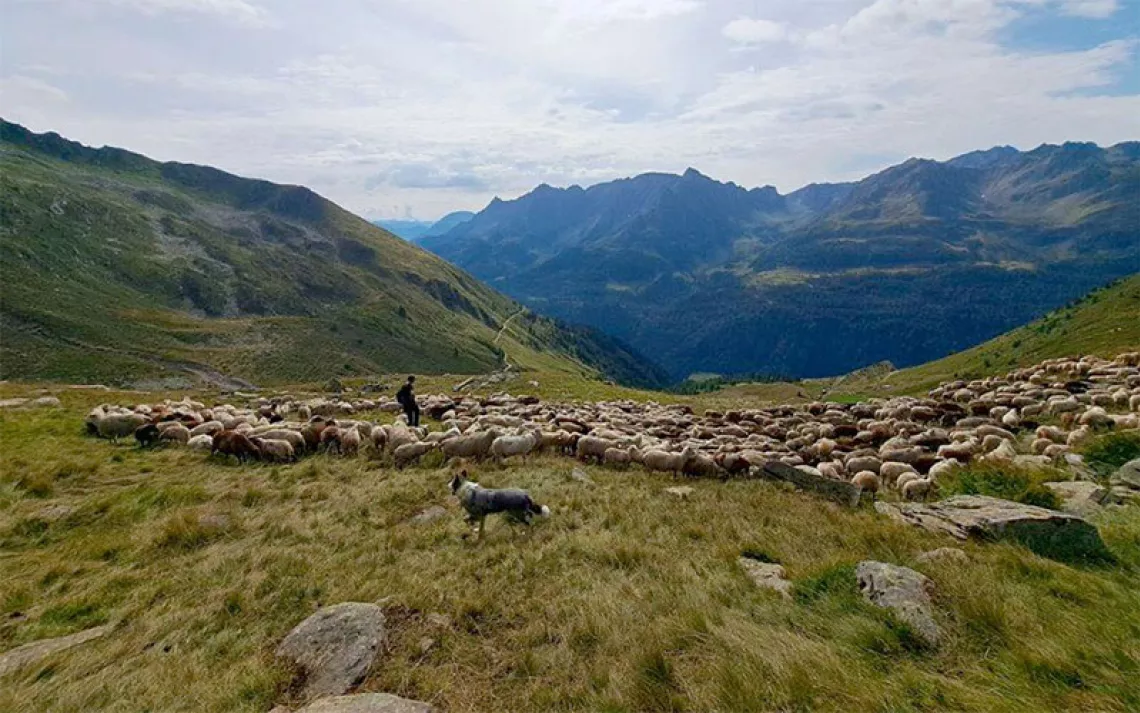What Will It Take to Fully Recover Wolf Populations?
National parks are important but insufficient for species revival

Photo by Jacob W. Frank/National Park Service via AP
In 1987, a farmer near the town of Pouce Coupe, British Columbia, saw four gray wolves on his property and shot one of them. The wolf happened to be radio-collared, and the farmer reported the collar to authorities. The data revealed that the five-year-old female wolf had traveled all the way from Montana’s Glacier National Park—a distance of some 540 miles. This wolf, which was among the first litter of radio-collared wild-born wolves in the western United States, had loped through protected national parks and private ranches, crossed interstate highways, dodged traffic, and, along the way, avoided the rifle crosshairs of ranchers—until it met the last one.
That one wolf’s story is significant because it illustrates the opportunities and challenges that confront any wolf trying to recolonize the species’ former habitats. Before that event, biologists knew, via radio-collar tracking, that wolves traveled as much as 30 miles a day—but they didn’t know how far they would disperse. “This wolf was miles and decades away from the Yellowstone reintroduction,” says Diane Boyd, who is now the wolf and carnivore specialist of Montana Fish, Wildlife, and Parks Region 1. “Wolves were making a strong comeback in Montana on their own, [even though] Yellowstone was in the limelight for their reintroduction efforts.”
When many people think of wolf restoration, they naturally flash on the historic reintroduction of wolves to Yellowstone National Park in 1995 and 1996. Most people aren’t aware that wolves were simultaneously reintroduced in Idaho’s Frank Church Wilderness of No Return, and that, even before those notable events, wolves naturally recolonized Glacier National Park, in far northwestern Montana, in the early 1980s. National parks like Yellowstone and Glacier, it turns out, are only one part of the wolf recovery story.
“Parks and wilderness areas aren’t big enough [for full recovery],” says Michael Jamison of the National Parks Conservation Association.
Today, wolves have successfully recolonized many western states, including Montana, Idaho, and Wyoming, while dispersals from those packs have migrated even farther outward to Washington, Oregon, and California and, more recently, to Colorado, Utah, and even Arizona. “This is the most successful conservation story in North America,” Boyd says.
As wolves rebound across the western United States, conservation biologists are looking at ways to connect migration routes that are independent of traditional land conservation models in order to allow the species to disperse and diversify its gene pool. Parks are a good start, but such protected areas are biological islands in a sea of private property, too small to hold on to all of their wildlife. Once wolves leave the safety and security of protected areas, they have to find suitable habitat, navigate roads, and dodge hunters and ranchers intent on killing them. In order to achieve full recovery, biologists and wildlife conservationists say, we need to connect together the isolated refuges of the parks. “We have to connect the dots,” Jamison says.
“Public land holdings are puppy factories,” says Carter Niemeyer, a retired US Fish and Wildlife Service wolf trapper who has studied wolves for 50 years and helped bring wolves down from Canada’s Jasper National Park to Yellowstone and Idaho’s Frank Church Wilderness. “They are essential for pumping out animals.” But if wolves leave their family pack, they have “a one-way ticket” out if they leave the park because “outfitters, hunters, and trappers are on the edge knocking the hell out of them.” Idaho law, for example, allows individual hunters and trappers to kill up to 30 wolves a year. “All the different categories of public lands are central to dispersing animals and migrating species,” Niemeyer says.
Despite the threats from hunters and other obstacles such as roads, gray wolves are thriving in a way they haven’t in generations. There are an estimated 145 wolves in eastern Washington, and now 22 packs and 158 wolves in Oregon. There are at least a thousand wolves in both Idaho and Montana. Wyoming has 311 wolves. Experts estimate that California has 15 to 20 wolves. Voters in Colorado recently approved a ballot measure directing the state’s parks and wildlife agency to reintroduce wolves there—the first time that wolf reintroduction has been initiated via a popular referendum.
“One of the most important keys to wolf recovery is dispersal,” Boyd says. Wolves are dispersing from the epicenters like Glacier, the Frank Church Wilderness, and Yellowstone and moving westwards with ease because there are continuous forest corridors. But if they move south out of Yellowstone into Wyoming, there is an open expanse of land where they are considered varmints and can be shot on site or even aerially gunned down in fracking fields. Lone wolves have trouble making safe passage to distant lands because of the old rancher mentality of "shoot, shovel, and shut up."
For the wolves themselves, such dispersals are often arduous; for humans, they can be inspiring. In 2009, a Yellowstone female made it to Colorado. In 2008, a female wolf named B-300 swam the Snake River to cross into northeastern Oregon from Idaho. The following year, she mated and had pups. One of them was the famous OR-7—the first wolf to appear in California in more than a century. That wolf found a mate and is now back in southwestern Oregon.
In 2014, wolf scat was found on the North Rim of the Grand Canyon in Arizona and later confirmed to belong to a gray wolf from the northern populations. Experts believe dispersals this far south means that the northern gray wolf populations could reintegrate with the Mexican gray wolf populations in the Southwest and help diversify the wolf gene pool. Also, in 2014, a four-year-old male from the Boundary Pack in northern Idaho was identified in Utah’s Uinta Mountains.
A few years later, OR-54, a pup of OR-7, was the 54th wolf to be collared in Oregon. Since January 2018, this female has traveled more than 8,700 miles looking for a mate. She never found one, and in the course of her search, she has crossed back and forth from Oregon to California twice, passing through nine counties. Along the way, the she-wolf also killed some livestock. In December 2019, her radio collar went silent.
If wolves don’t get shot once they leave protected areas, there is a very high chance they will be hit by a car. The 4.18 million miles of roads that crisscross the United States carve up and fragment important habitat. In an early sign of wolf expansion, eight years after the Yellowstone reintroduction, a two-year-old female from Yellowstone’s Swan Lake pack was hit on Interstate 70 near Idaho Springs, Colorado. And once a road is constructed, it opens up former wildlands to the disturbance of human development and more habitat loss.
So, have wolves fully recovered?
Not exactly. The only truly healthy wolf populations that remain are in Alaska and Canada, where 90 percent of the wolves in North America live. This is mostly a function of viable habitat: Most of Alaska and Canada are undeveloped, and so there are simply fewer people, fewer hunters, fewer antagonistic ranchers, fewer vehicles, and fewer roads. In the Lower 48, wolf recovery—for all of its successes—remains precarious. According to the Center for Biological Diversity, there are no more than 6,000 wolves in the continental United States, and they occupy less than 10 percent of their historic range.
Boyd says she was midway through her career before she realized “people were going to make or break wolf recovery.” She smiles and reflects about how she loved wildlife but dreaded people. “Basically, the first 10 to 15 years of my career, I was kind of a misanthrope living in the North Fork Valley and running crews of dedicated volunteers. All we did was live and breathe wolves.” Now she spends most of her time creating “wolf tolerance zones” by mitigating problems with farmers and ranchers and correcting information. “Only through education can conservation be implemented.”
Boyd and Niemeyer agree that a lot of wildlife management is spent at the kitchen table in a ranch house, drinking coffee and getting acquainted. “Talking about the issues as well as forming relationships of trust,” Niemeyer says.
But even if conservationists succeed in cultivating human tolerance of wolves, the animals will remain isolated in protected areas unless we can construct migration corridors. Wolves and other animals don’t, of course, understand borders and boundaries as lines drawn on the maps. “The flipsides of boundaries are connections,” Jamison says. “Critters are going to go where critters have always gone, and sometimes that is inconvenient for us to figure out.”
That means that the old methods of conservation need to evolve into more complementary land-use models that include private lands held in conservancies and agricultural lands featuring a matrix of working acreage and wildlands. “Conservation has to wrangle with a pretty colonialist past of just putting lines on a map around pretty places that happened to be other people’s homes for thousands and thousands of years,” Jamison says.
One example of a new land-use designation is the proposed 130,000-acre Cultural Heritage Area in the Badger-Two Medicine portion of Montana’s Lewis and Clark National Forest. If established as envisioned, roughly half of the area will be set aside for conservation and the other half for cultural heritage preservation. “We have to work and heal our relations because all of the easy stuff has been done,” Jamison says. “New designations will deal with the fact that humans live here. But that is what connectivity is: linking up migrations and corridors by connecting the islands through existing land ownership and connecting people.”
In other places, wildlife migration corridors can be established through relatively simple methods such as building wildlife overpasses or underpasses to allow safe access across highways and interstates—a measure that also cuts down on vehicle collisions with wildlife and saves both animal and human lives. Another strategy is to create wildlife-friendly ranches that, among other measures, commit to removing the lowest strand from barbed-wire fences to allow pronghorn antelope to move through, or removing fences and opening fence gates at certain times of the year to allow elk or other game to move through. “Wolves can get around most obstacles, but the fewer the fences, the more receptive the land is to dispersal and migration of wildlife the better,” Niemeyer says.
“Nature’s a nomad, and she needs to move now more than ever because of a rapidly changing climate, compounded by the rapid development of landscapes, whether it is for industry or for highways or subdivisions,” Jamison says. “Critters are forced to move in ways they’ve never been forced to move before.”
There’s an old Russian proverb: Wolves are fed by their feet. Wolves are, truly, a species always on the move. Today, they are on the road to recovery. To truly thrive, they need us to connect the islands of protected areas into a continent-wide network of wildness.
 The Magazine of The Sierra Club
The Magazine of The Sierra Club







